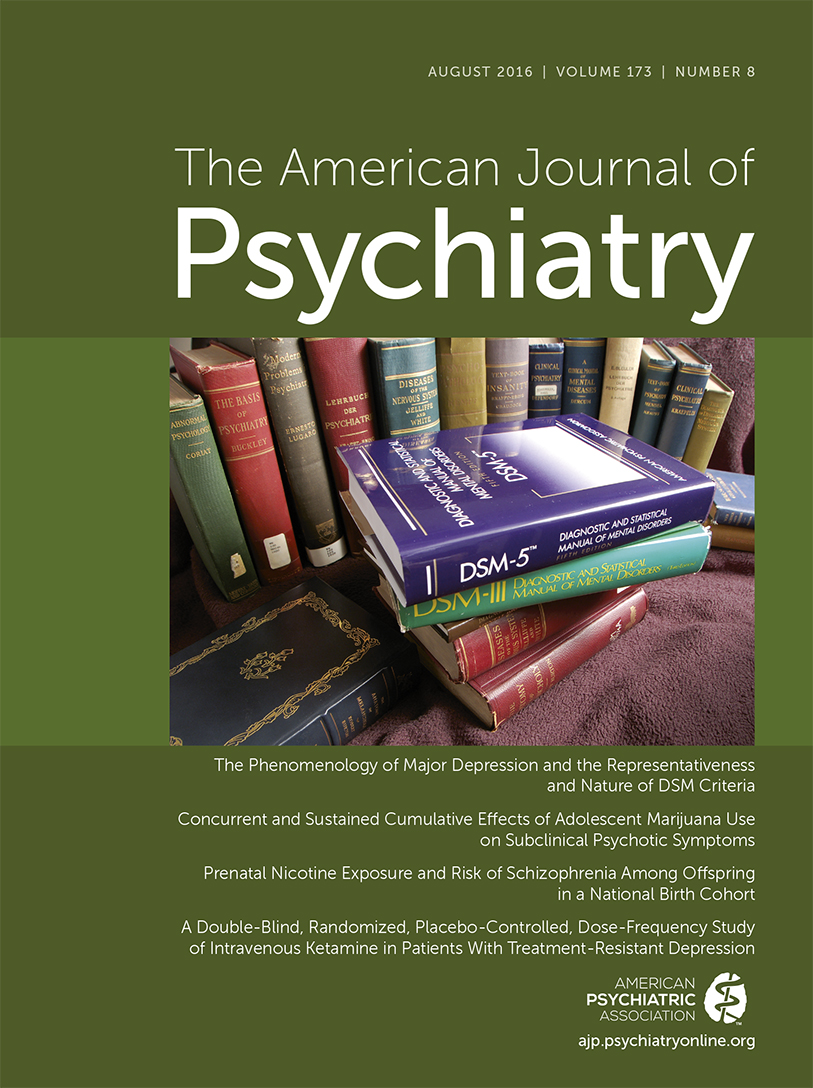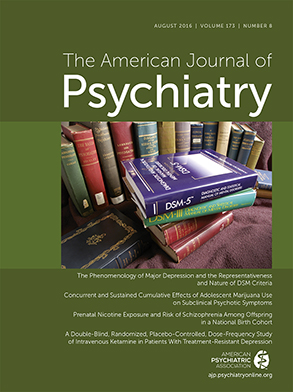Recent policy changes have raised interest in the adverse and therapeutic effects of marijuana. One area of interest is the relationship between adolescent marijuana exposure and subsequent psychosis. This relationship has been of special interest since at least 1987, when Andreasson et al. published their 15-year follow-up study of over 45,000 Swedish conscripts (
1). The findings showed that compared with those who did not use marijuana by young adulthood, those who used it 50 or more times had a sixfold increased risk of developing schizophrenia. Since then, at least four other prospective studies have shown that adolescent or young adult marijuana use predicts the onset of psychosis and/or psychotic disorders in adulthood (
2–
5).
However, the exact nature of the relationship between marijuana exposure by young adulthood and subsequent psychosis is not clear. For example, is this relationship confounded by factors such as other substance use? Is the psychosis temporary or permanent? Or are people with psychosis more likely to use marijuana in the first place? The current study by Bechtold et al. (
6) addresses some of these important questions.
This study followed a community sample of 1,009 boys from age 13 to 18. Assessments occurred every 6 months. Psychosis was measured with five items from the Youth Self Report form (e.g., “You hear things that nobody else seems able to hear” and “You have thoughts that other people would think are strange”). Substance use history was obtained using a self-report questionnaire. Analyses examined whether marijuana use predicted symptoms of psychosis up to 5 years later. They also examined whether psychosis predicted subsequent marijuana use.
Results showed that for each year the boys used marijuana 52 times or more (“weekly use”), they had a 21% increase in the number of subsequent psychotic symptoms. Similarly, for each year of weekly use, the odds of experiencing paranoia increased by 133% and hallucinations by 92%. Importantly, the risk of psychosis following marijuana exposure increased even after at least a year of abstinence. For example, for each year of weekly marijuana use, the total number of psychotic symptoms increased by 29% even if adolescents abstained from the drug for at least a year.
The study also had various important negative findings. For example, symptoms of psychosis did not predict subsequent marijuana use. Furthermore, daily tobacco use, weekly alcohol use, or lifetime history of drug use other than marijuana did not predict the number of self-reported psychotic symptoms.
In summary, this study has various important findings. Adolescent marijuana use predicted subsequent symptoms of psychosis, while psychosis did not predict subsequent marijuana use. This finding held even after youths abstained from marijuana use for at least a year. Furthermore, alcohol, tobacco, and other substance use did not predict the subsequent number of psychotic symptoms.
Strengths of the study include its prospective design with good rates of follow-up (e.g., 70% of the sample had no missing data). This research is also very timely. The limitations are also important to note. First, this sample of boys may not generalize to girls. Second, while subclinical psychotic symptoms predict a 3.5-fold annual increased risk of developing a psychotic disorder, the exact meaning of self-reported psychotic symptoms is not clear (
7). Third, the study relied on self-report of marijuana use. There was no laboratory confirmation of use. Finally, no study can control for all possible confounds related to adolescent marijuana exposure and psychosis.
Nevertheless, this study significantly advances the field. This and other studies show a preponderance of evidence linking adolescent marijuana exposure to subsequent psychosis, and the findings have important research and clinical implications.
In terms of research, studies are needed to examine the nature of the relationship between adolescent marijuana use and psychosis. Since studies that randomize adolescents to marijuana or placebo would be unethical, researchers will have to develop creative ways to study this relationship and to determine if causality exists. Fortunately, a model for evaluating causality was developed to investigate the relationship between smoking and cancer. This model includes evaluating the coherence (plausibility), consistency, dose-response relationship, experimental aspects (e.g., Does cessation of use decrease risk?), specificity, strength, and temporality of associations (
8). Such a model may be adapted for use in this situation.
There are also various clinical implications. First, in the past, some clinicians may have viewed marijuana as “just pot.” However, new evidence suggests that adolescent marijuana use may have significant health implications. Second, evidence-based substance prevention programs should be implemented to reduce the prevalence of adolescent marijuana and other substance use. Finally, given that only 1 in 10 adolescents with a substance use disorder accesses treatment, steps should be taken to increase access to evidence-based interventions, such as motivational interviewing, cognitive-behavioral therapy, and/or family therapy (
9).

